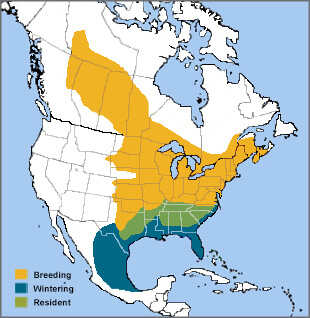
Eastern Phoebe range map by ABC
The Eastern Phoebe may lack the visual appeal of a Northern Cardinal or Scarlet Tanager, but this drab little flycatcher is just as popular among birdwatchers. It's easy to identify, both for its onomatopoeic calls and tail-wagging habit. And it's often in view: An Eastern Phoebe pair will often nest on or near human-made structures. The species is a reliable herald of spring, as one of the earliest songbirds to return to eastern U.S. breeding areas.
The unusual spelling of the Eastern Phoebe's name harkens back to Greek mythology: Phoebe was the daughter of “Earth” (Gaea) and “Sky” (Uranus), another fitting tie-in to this outdoor neighbor to many.
The Phoebe Came Back
Famed ornithologist and artist John James Audubon was particularly familiar with and fond of the Eastern Phoebe, which he called the "Pewee Flycatcher." The species nested around his home in Mill Grove, Pennsylvania, where Audubon courted his neighbor and future wife Lucy Bakewell.
In 1803, Audubon carried out the first bird-banding experiment in America at Mill Grove, when he attached silver thread to the legs of Eastern Phoebe nestlings before they migrated. The next spring, he recaptured two of the marked phoebes, which had returned to his property. From that time until today, ornithologists have employed bird banding to track birds' migratory movements and to ensure accurate counts of their populations.

Eastern Phoebe building nest in Sterling Forest State Park, NY, by Michael Stubblefield
Late Away, Back Early
The Eastern Phoebe breeds in eastern North America, then migrates to wintering grounds from the southeastern United States to southern Mexico. It's one of the last birds to head south, often lingering until late fall. The Eastern Phoebe is also one of the first migrants to return to the breeding grounds in spring.
The Eastern Phoebe's call is a sharp chip, and its song, from which it gets its name, is a raspy, persistent fee-bee.
Listen here:
(Audio: Jonathon Jongsma, XC132866. Accessible at www.xeno-canto.org/132866 · Robin Carter, XC1375. Accessible at www.xeno-canto.org/1375)
Phoebe Pest Control
The Eastern Phoebe is an insectivore, like related species including the Olive-sided Flycatcher and Southwestern Willow Flycatcher. Like other flycatchers, it forages using a "sit and wait" strategy, perching with tail a-wag until it spots prey, then darting out to catch it in mid-air. It also gleans invertebrates from foliage, the ground, or water surfaces. Eastern Phoebes take many insects that humans consider to be pests, including wasps, flies, spiders, centipedes, and ticks. They also eat some small fruits, especially berries, which come in handy during colder months when prey is scarce.
Double-brooded Duo
Historically, Eastern Phoebes nested on cliff ledges and in caves, but the species has adapted to human structures as well, now often nesting on building and bridge ledges or under culverts. This adaptability has allowed the Eastern Phoebe to tolerate human changes to the landscape, and even expand its range.
Phoebes are early nesters throughout their range. Once a female accepts a mate, she begins construction of an open-cup nest of mud pellets covered with moss and lined with grasses and other soft materials. There, she lays two to six eggs. Both parents take turns incubating, and the clutch hatches after about 16 days. The male and female phoebe also share chick-feeding duties. Phoebe nestlings fledge after about two weeks, and the adults usually re-nest and raise a second brood.
Part of Changing Landscapes
Eastern Phoebe numbers have increased due to the species' ability to live alongside people. That doesn't mean these birds are free from dangers. Their nests are often parasitized by Brown-headed Cowbirds, which eject phoebe eggs before laying their own. And like other adaptable and increasing species such as the American Robin, the Eastern Phoebe must still contend with human-wrought threats including outdoor cats and pesticides. Many of ABC's policy programs help to reduce the impacts of these hazards. We also offer tips on improving your habitat to make it more welcoming to the Eastern Phoebe and other birds.
Donate to support ABC's conservation mission!



















































